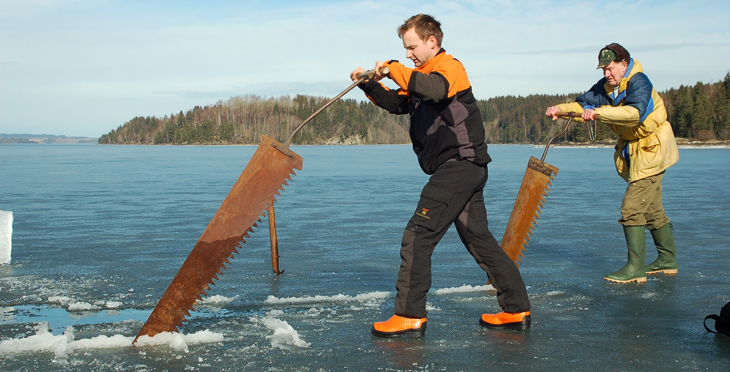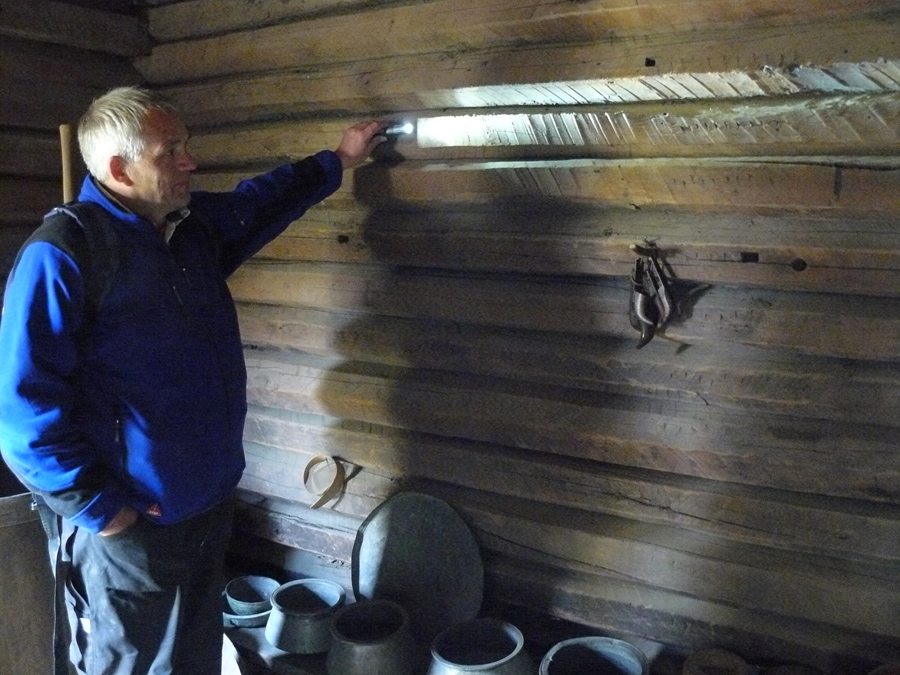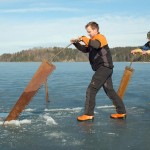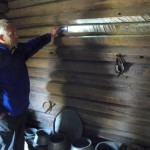By Director Eivind Falk, Norwegian Crafts Institute – Centre for Intangible Cultural Heritage.
The rich tradition of crafts is like a treasure chest. The many variations and diversities in boat building, traditional costumes, wood carving and log houses are a rich material refined through generations – a wonderful gift handed over from our ancestors. It is amazing to open the craftsmen’s chests and see some of the complex diversity in traditional craftsmanship, and it is our responsibility, as a society, to hand it over to the next generation.
Since 1987, The Norwegian Crafts Institute, which includes The Centre for Intangible Cultural Heritage, has on behalf of the Ministry of Education and Ministry of Culture worked with the protection and continuation of various traditional crafts through more than 500 different projects. Most of the projects we run are situated in Norway, but we are also responsible for safeguarding measures in other countries such as the Czech Republic, Latvia, Hungary, Scotland, Bulgaria, Georgia and Iceland. For our projects, we have developed a methodology for the continuation of craftsmanship. I will describe the methodology in this article.
Action-born knowledge
A lot of knowledge in our society is theoretical, for example, history or geography, and can easily be consumed through reading books or using the web in order to learn. The craftsman’s knowledge often is what is called action-born knowledge. We use this term to describe how craftsmanship is in the practice and in the action. The term describes, in a good way, how the living craft is best carried on. The transfer usually takes place in a working environment where the traditional craftsman hands the tradition over to the one who acquires it. Although living craft knowledge is individually stored in the craftsman, it is important to keep in mind that tradition is refined and built over time, through generations.
The knowledge is built gradually by watching others perform the craft and then trying to do it oneself. Much will be time-consuming to learn and requires a lot experience to be a good performer. For a craftsman to become an even more proficient practitioner in his field, it is important to have the opportunity to develop through meeting other professionals, tradition-bearers, and challenging tasks. This method ensures that the craftsman will develop and build competence for performing at a higher level.

The experienced blacksmith Terje Granås is a good example of a craftsman performing on a higher level
The three-year fellowship scheme for craftsmen, which has been practiced since 1996, is an example of this. There is a big difference between a course where one might get a little taste or knowledge of a technique and specialization acquired over a longer period. Here the artisan, through working with someone who is skilled and through constant repetition, builds up his skills and knowledge to be an even better performer. In our experience, it is appropriate to set aside at least three years. It could easily be more.
When our former carpentry fellow, Trond Oalann, finished his three-year period, he emphasized that he would like to continue for another three years. He had, in his own opinion, just started his process of obtaining the skills and knowledge. Maybe we have something to learn from the Japanese? In the book Zen and the Art of Archery, Eugen Herrigel describes the process by which the impatient student learns the art of shooting with the Japanese bow (p. 41). It takes two years before he is allowed to release the string:
“The road to become a Master is very steep. The target of becoming a Master will be Achieved by the trust in the Master, and for long time periods nothing else than the trust of the Master will continue to bring the trainee on towards the target. The Master is a living ideal for the trainee’s own conviction and self-confidence and his presence is convincing by just being there. At this stage the trainee will reach his highest stage in copying the master. He will be part of the Master by copying.”
In the least, it will be important with a high level of expertise when the practitioner will embark with demanding tasks in cultural heritage, where he can really be put to the test: it can be to read and interpret the tools’ traces and patterns left by a craftsman who is long gone. What kind of tools has been used? How have they been shaped? How have they been used? It might be saying something about the use of materials and their quality, or it might say something about the maintenance afterwards. There will be examples of knowledge which, primarily, a skilled and experienced craftsman will be able to know something about because the practitioner’s knowledge in the field is unique in its practical approach. An experienced craftsman can, from his or her point of view, provide useful information and knowledge that could complement the ethnologist, curator and architect disciplines.
In recent years, particularly in the field of cultural heritage, we have experienced an increasing demand for craftsmen with a deeper expertise in their discipline. In the Norwegian Directorate for Cultural Heritage (Riksantikvaren), the section for Cultural Heritage at the county level and at the museums, there has been a change of attitude in which there are increasing demands for craftsmen at a higher level of performance. This may include bricklaying, painting or carpentry.
Tradition-bearer
We usually like to say that craftsmanship is best transmitted in a 1:1 situation from one professional to another. The heritage we are safeguarding is in a person, a craftsman who manages a tradition. The tradition-bearer is therefore the most important person in the project. It is his or hers knowledge we aim to secure.
Often the knowledge is of a very complex and comprehensive nature. It can, for example, be to put on a turf roof in a particular tradition. It will require a comprehensive knowledge of construction, quality of materials of clay, earth, wood and botany – not to mention the maintenance afterwards. The difference between knowledge of (that is something one has read about) and knowledge in (traditional living knowledge) will be enormous, and likely to be crucial for a successfully built roof or not. In worst case, will water leak into it afterwards or not? It’s, therefore, important to safeguard the traditional knowledge, not only because it is of cultural importance, but also because, in a purely economic perspective, it would be wise to choose the safe instead of the unsafe. It is expensive to replace roofs after two years.
Sometimes there can be more than one carrier of the tradition. It may be that a project starts with one tradition bearer but develops gradually on the way. It can happen because the project is spoken about in the village where knowledge transfer occurs, or because it is referred to in the local newspaper, or because someone reflects “Yes, he was living there. I think he might know something about this! Didn’t he and his grandfather together cover the walls of the barn with juniper in the traditional way? Was it not he who felled trees in the old way? Was it not he who was present when your grandfather sourced materials? “In this way new information, which was unknown when the work began, might be uncovered on the way. It is, therefore, important to be open to new and important knowledge and sources during the project.
In our experience, it is important to compensate the craftsman or -woman for lost earnings if he or she is brought into a project or a workshop. This gives a clear signal that the knowledge has a value. This type of compensation is, therefore, important even if the craftsman is retired and no longer works.
Tradition-carrier, Karl Garder, is 94 years of age. His knowledge of harvesting ice is very valuable. Once he worked in an important part of the Norwegian economy in a trade now mostly forgotten. He is probably one of the very last practitioners who have been a part of this important heritage in Norway. From when he was a little boy, Karl helped his father producing ice blocks in Frogn community, and Karl’s father made his living from cutting, picking up and transporting the ice. Karl kept his skills viable by producing ice for farms and other buyers even after the golden export time was over. His knowledge in handling this material is therefor unique.
It has been documented and written extensively about the cutting of ice and the export of ice, but the living knowledge of cutting and handling ice was about to disappear. In order to safeguard this tradition, we organized, in collaboration with the local Museum in Follo, a project where we transferred much of Karl’s knowledge of the craft to the young ice cutter, Thomas Orderud, from nearby Trøgstad. By giving them the opportunity to work together over time with traditional tools at the lakes Øyeren and Mjøsa, we secured that some of the living heritage, which Karl carried and possessed, was passed on to a new generation.
The practitioner learning
The bearer of the tradition’s knowledge is vulnerable. When he or she is gone, the traditional knowledge disappears. It is, therefore, very important to protect the craft while it is alive. To reconstruct lost heritage in the aftermath is very expensive and time consuming, and how can we be sure that the reconstruction is correct?
First and foremost, we ensure that knowledge is transferred to another practitioner through a practical situation. This should be a craftsman who is skilled and therefore more easily is able to absorb knowledge from the tradition-bearer. According to our experience, it is of great importance that the craftsman learning from the tradition-bearer is a skilled person. Sometimes it can go smoothly with several professionals in a project, but we have the best experience with the 1:1 model, with one craftsman learning from one tradition-bearer. If you choose to have several professionals on a project, experience shows that it might just happen that the tradition-bearer favorurs one of them – the one who is best at, or who has the most ability to, absorb the knowledge. In other situations, more than one practitioner works well. A project of traditional ski-making in the cradle of modern skiing, Morgedal, is a good example where practitioners, Terje Haugen and Tarjei Gjelstad, periodically followed tradition-bearer Åsmund Kleiv during several years. They were in the woods, chose materials and went through all the processes from choosing the tree in the forest, selecting the materials to be cut, drying and preparing the wood to finished skies, in the unbroken tradition after the renowned ski-maker and skier, Sondre Norheim. Even bindings from birch and traditional shoes were made as part of this project. In order to secure local sustainable knowledge, we worked closely with the museum, Norsk Skieventyr, and Telemark Research Institute.
Documentary
In addition to linking tradition-bearer and the practitioner, it will usually be important to document the work being done. It can be done with video, photography, interviews, sketches or other kinds of documentation techniques. The most appropriate way to do the documentation will vary from project to project. However, it is important that the one doing the documentation does not interfere with what goes on between tradition-bearer and practitioner. We usually say that the one doing the documentation should be like a flie on the wall.
What should such documentation material be used for? This will be an especially important source for the practitioner after the tradition-bearer has passed away. The Norwegian Crafts Institute has extensive experience showing that the practitioner, often many years after a project is completed, are returning to study details. Perhaps the tradition-bearer is gone and the craftsman has no one to ask anymore. In these situations, the documentation material is an important source for the person who will carry on with the tradition.
Who is this person to do the documentation? Very often it will be a skilled craftsman or woman. This will often be a wise choice, because the practitioner knows better what should be documented. When, for example, doing the video filming, he or she more easily can concentrate on what’s important. It could be a grip or a way to use the tool. It could be the craftsman’s way to stand while axing. All details of the work can be significant, and there might be details one might not think of if one is not familiar with the craftsmanship. Doing documentation is, therefore, often very demanding, because it comes to capturing what is essential – not only at the time, but maybe in ten years after the tradition-bearer is dead and tools are packed away. It’s not about making pretty pictures or funny movies, but primarily documentation for later use, for practitioners to be able to understand what they see.
Is there a recipe for the kind of documentary material and methods which is the best? There is no clear answer to this question. Very often, video material will be important, because it shows the craftsman’s motion, grip and use of tools in a way that will give the practitioner a useful starting point for understanding what is happening. It may also be wise to take still pictures. In addition, sketches, drawings, a diary and notes can be useful supplementation. Sometimes also audio recordings of interviews with a tradition-bearer is a nice way to fill in pieces of the picture of knowledge that is about to disappear. Type and scope of documentary material will, therefore, vary from project to project. There will, for example, be differences in documenting the production of a pair of slippers made of straw in Laksevåg, close to Bergen, and the construction of a traditional wooden boat in Åfjorden, not far from Trondheim.
Rocambole was not dead!
In Pierre Alexis Ponson du Terrail’s books about Rocambole, the situation was often extremely critical, and many a time the reader was led to believe that it was the end of the book’s hero. But the readers were tricked. When we all were sure it was over, he rose again from the most hopeless situations in order to fight back cruelly: ” … but Rocambole was not dead!” Many a times, this has also been the surprising case for traditional craft as well.
Many times we have heard that a tradition is broken; “This is a technique that no longer exists as a living tradition,” “All tradition-bearers are probably dead.” On behalf of UNESCO, master carpenter hans Marumsrud and I started looking for a certain axing technique, the fishbone pattern technique, in Georgia. We were told: “No one is doing this anymore.” But we did not give up. We wanted to investigate further because it would be of immense value if we managed to find a practitioner. The technique would obviously be crucial for craftsmen who were working at the National Museum in Tbilisi as it appeared in a number of buildings at the Chitaia Open Air Museum.
Sometimes it might be wise to ignore the messages that tradition is broken. So did we when it came to the fishbone pattern technique in Georgia. With support from UNESCO, The Georgian National Museum and the Norwegian Cultural Heritage Directorate, we chose to organize field work in an area where we knew the tradition had been strong and where many older craftsmen still lived. We hoped that we might find something. The decision turned out to be wise. We found several tradition-bearers who were familiar with and practiced the technique. Admittedly, several were well up in their 80’s and 90’s, yet they were in good health and willing to teach. This way we can facilitate that this important part of the cultural heritage is not lost but can continue from generation to generation, as it is formulated in UNESCO’s Basic Text (UNESCO, 2012 p.5 The Convention) Convention for Safeguarding the Intangible Cultural Heritage.
The same situation has also occurred in Norway. A tradition may well be considered broken until we begin to unravel it. When skilled craftsmen gather to scratch their heads and start axing, carving or doing the dry stone walling together, it turns out, once again, that puzzle pieces find their place and that tradition was not quite dead yet. Once again, Rocambole surprisingly is alive.
The Academic community as a method
In academic tradition, peer review is an important tool for quality assurance of theories and publications. Also within crafts, we have many competent experts who will be important for thoughts and theories to be tested. It was important for Norwegian Crafts Institute to actively involve other research groups in our efforts to build and ensure quality. Good examples of such groups, we find at the Sør-Trøndelag University College, in the Norwegian directorate for Cultural Heritage, at Maihaugen Museum, in Røros, Dovre and at Bryggen in Bergen. In Sweden, for example, we find such groups at the Handicraft Laboratory in Mariestad and the University in Gothenburg. By being able to test crafts theory in a competent environment, we can get confirmation or a major correction.
An example of this is a project Norwegian Crafts Institute started in 2010 with focus on traditional production of windows and glazing bars. It turned out that a lot of knowledge about how this was actually done was missing. Through repeated meetings with skilled craftsmen from Norway and Sweden, Norwegian Crafts Institute has been able to put together some of the key puzzle pieces in terms of tools, techniques and materials. The project continues and contributes to increased knowledge in the field. There are still many blank spots on the craft map. In order to safeguard and restore traditional buildings and constructions, the knowledge of non-industrial production of such windows and doors is a crucial key in the years to come. Hopefully, this project will be able to provide useful information to various restoration projects in the future.
Litterature
Falk, Eivind (red.) (2007). Maihaugens Yearbook 2007, Lillehammer: Norsk handverksutvikling NHU / Maihaugen
Falk, Eivind / Wallin-Weihe, Hans Jørgen (2009) Living Crafts, Stavanger: Hertervig Akademisk
Herrigel, Eugen (1987). Bueskydning og Zen, Købehavn: Sphinx forlag
UNESCO (2012). Basic Text of the 2003 Convention for the Safeguarding of Intangible Cultural Heritage 2012 Edition, Paris: UNESCO Intangible Cultural Heritage section
Ponson du Terrail, Pierre Alexis (2012) (Originally published in the period 1859-1884) Rocambole, London: Black Coat Press
Det Kongelige Kultur og Kirkedepartement (2008-2009) St. mld. Nr.49 Framtidas Museum. Printed version. Oslo: Departementenes servicesenter










Hola como estan soy de prosedencia GRECO ROMANO,de las grandes familias de Europa, quisiera veneficios para mi comunidad.